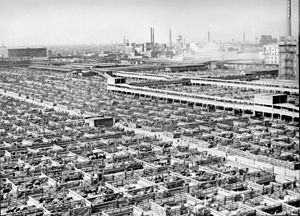Union Stock Yards
The Union Stock Yard & Transit Co., or The Yards, was the meatpacking district in present-day New City, Chicago. The yards were opened in 1865. Vanderbilt money sponsored the yards.[1] It was active for 106 years.[2] The yards inspired Upton Sinclair to write his book The Jungle.[3]

The stockyards became the important point of the rise of some of the earliest international companies. The stockyards have become an important part of the popular culture of Chicago's history.
From the Civil War until the 1920s and peaking in 1924, more meat was processed in Chicago than in any other place in the world.[4] The Yards closed on July 30, 1971, after several decades of decline during the decentralization of the meatpacking industry.
It was designated a Chicago Landmark on February 24, 1972,[5] and a National Historic Landmark on May 29, 1981.[6][7]
References
change- ↑ J'Nell L. Pate, Livestock Hotels: America's Historic Stockyards (Texas Christian University Press: Fort Worth, Texas, 2005) p. 79.
- ↑ Pacyga, Dominic (2005). "Union Stock Yard". Chicago Historical Society. Retrieved March 7, 2007.
- ↑ Sandburg, Carl (1916). "1. Chicago". Bartleby.com. Retrieved June 15, 2009.
- ↑ Wade, Louise Carroll (2004). Grossman, James R.; Ann Durkin Keating; Janice L. Ruff (eds.). Meatpacking. University of Chicago Press. ISBN 0-226-31015-9.
{{cite book}}:|work=ignored (help) - ↑ "Chicago Landmarks". Chicago Landmarks. Archived from the original on February 3, 2007. Retrieved March 6, 2007.
- ↑ "National Historic Landmarks Survey: Listing of National Historic Landmarks by State: Illinois" (PDF). Archived from the original (PDF) on October 18, 2012. Retrieved March 7, 2007.
- ↑ "Old Stone Gate, Chicago Union Stockyards". National Park Service. Archived from the original on May 28, 2008. Retrieved March 30, 2007.